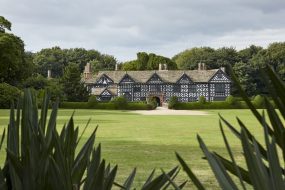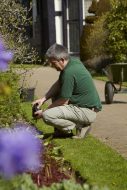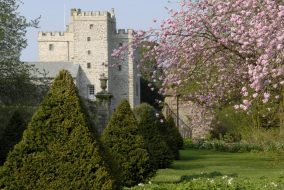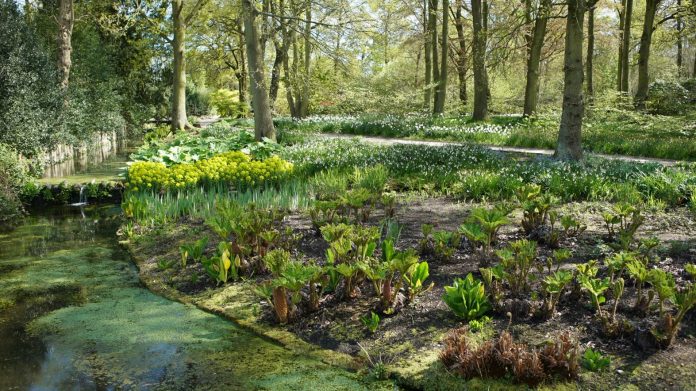At a time of year when National Trust gardens are bursting into bloom, it’s usually a case of all-hands-on-deck to get them looking their best for the thousands of visitors who pass through their gates.
But in the current situation, the gardeners who care for these formal borders, vibrant displays and well-kept lawns are having to propagate new ways of working. With fewer green fingers to carry out the work and nature becoming bolder in the absence of visitors, the gardeners at National Trust places in the North West have shared how they’re keeping calm and carrying on in these unprecedented times, with a few surprises along the way.
Quarry Bank
More commonly known for the mill which once stood at the heart of this bustling industrial community, the gardens at Quarry Bank have become the hive of activity and life. The recent good weather has encouraged some early bloomers in the valley garden including Quarry Bank’s rhododendrons which usually flower in May/June. Many of the heritage species were planted by the Greg family who built the mill and Robert Hyde Greg, the second owner. Once the vital resource which kept the wheels of this industrial powerhouse turning, water is also playing an important role in ensuring new plants added to the gardens before lock-down survive this period. Quarry Bank Gardener, Peter Moffat says: 
“Right now it’s just about keeping our gardens alive in this warm, sunny weather we are currently having. Lack of water can put a tree or shrub under a lot of stress and this is when pests & diseases can strike, when the plant isn’t at its strongest and can’t fight them off. We obviously want keep them strong and looking as good as they can so they’re able to give visitors a bright welcome when the time comes.”
With the gardens being closed to visitors and a reduction in air traffic from neighbouring Manchester airport, Peter Moffatt has been able to get some time away from the watering to enjoy the increase in birdsong. There’s been a noticeable increase in ducks bobbing along the River Bollin which snakes through the gardens. Peter is confident the gardens will welcome more ground-nesting birds over the coming weeks with little to disturb them. Peter is also making sure that the volunteers who work though all seasons and weather to care for the gardens under normal circumstances are kept in high spirits by sending them regular updates on what’s in bloom along with photographs so they can keep an eye on what’s happening from afar.
Dunham Massey
The gardens at Dunham Massey were once exclusively kept for the Earls and their families. Under these current circumstances similar restrictions apply again with only head gardener, Emily Chandler, and local wildlife making daily visits. Visitors who usually stay away until afterhours have also been taking advantage of the quieter gardens with foxes spotted during the day and the sound of tawny owls too. Fewer footsteps has also meant that the grass has become greener, with scarifying and reseeding that took place just before lock-down having the chance to get to work. Weeds have become a bit of a headache with few hands to help too.
As we all wait to hear when lockdown might be lifted, Emily could face quite a task from June as the rose garden comes into colour. There are over 150 different varieties of roses, including ‘Dunham Massey’ and ‘Stamford’s Sanctuary’, named to commemorate Dunham’s past as a First World War hospital.
Over the summer months it can take National Trust gardeners and volunteers over 75 hours each week removing all the dead heads to keep the rose garden looking its best – quite a task for just one person. In the meantime, good news comes in the form of fruit trees. A number were planted in the kitchen garden after a legacy donation was given to the property. With National Trust gardeners permitted to carry out essential work, it’s meant that the trees could be watered and maintained so they’ll make it through these unprecedented times.
Speke Hall
Machinery is helping to make lighter work for fewer hands in the gardens that surround this black-and-white Tudor manor house. Area Ranger, Ian Ford, and Gardener, John Jackson, are working together to get through the list of basic maintenance tasks including mowing, strimming and edging. Different machines have been introduced to their work to help them get around the grounds as quickly as possible.
For instance, tractor mounted mowers are being used to cut the lawns instead of pedestrian mowers. Like Quarry Bank, Speke Hall sits beside a busy airport and industrial area. But the reduction in both air traffic and local hustle and bustle has made wildlife more pronounced at Speke. Ian says:
“Spring bird song is much more noticeable due to the lack of noise, not only from visitors but from planes, building work and traffic noise. The birds also are nesting in areas where they would never usually. A Wren has commandeered a Swallow’s nest right outside the front door of the hall and a Nuthatch is nesting in a tree right beside a path which is usually bustling with visitors.”
Lyme
As the second highest garden in the care of the National Trust, at 850 feet (260m) above sea level, it blooms slightly later than many other gardens. Usually maintained by a team of 65 volunteers and 4 gardening staff, it’s now in the care of just one, very safe pair of hands. Head Gardener, Sarah Witts has her work cut out for her, so she’s taking a different approach to what she cuts and what she doesn’t. The lawns are being left to grow longer which has allowed daisies, dandelions and speedwell to flower – welcome fodder for pollinating insects like bees and butterflies.
 Sarah’s also thinking creatively to keep the weeds at bay within the formal borders and the Italian Garden. Rather than removing the weeds by hand, Sarah is using a mulch to suppress the weeds and to reduce the amount of watering required. This will help the Herbaceous borders to continue their recovery from the catastrophic flooding at Lyme in July 2019. Water ripped through the garden and cleared areas of well-established plant life. Similar to other National Trust places in the North West, the gardens at Lyme have seen an increase in wildlife as well as some less expected visitors. Although Lyme’s resident herd of red deer are kept strictly out of the garden, roe deer have been popping by and making the most of the quiet. Lead Ranger, Chris Dunkerly was lucky enough to capture a pair of the roe visitors on a wildlife camera set up in the garden.
Sarah’s also thinking creatively to keep the weeds at bay within the formal borders and the Italian Garden. Rather than removing the weeds by hand, Sarah is using a mulch to suppress the weeds and to reduce the amount of watering required. This will help the Herbaceous borders to continue their recovery from the catastrophic flooding at Lyme in July 2019. Water ripped through the garden and cleared areas of well-established plant life. Similar to other National Trust places in the North West, the gardens at Lyme have seen an increase in wildlife as well as some less expected visitors. Although Lyme’s resident herd of red deer are kept strictly out of the garden, roe deer have been popping by and making the most of the quiet. Lead Ranger, Chris Dunkerly was lucky enough to capture a pair of the roe visitors on a wildlife camera set up in the garden.
Rufford Old Hall
The lock-down has encouraged many into their gardens. For some this may be a return to a task they haven’t done in a while, or an entirely new pursuit. For David Roberts, Head Gardener at Rufford Old Hall, it may come as a surprise that the current situation has meant he too is able to get stuck in again. David says:
“As I’m not doing my normal day job it means I’ve been freed up my time to do more gardening, which is something I haven’t been able to do for years. Usually I spend my days managing our staff and volunteers, speaking with visitors or running events, but I’m finding this new normal quite refreshing, relaxing and enjoyable. The garden has been quiet and free from human noise, but bird song seems almost magnified with Blue tits, Great tits, Coal tits and Robins. I have heard and seen three or four buzzards overhead and the kingfisher on the canal made me stop for a while to connect with nature and watch in wonder. They have been there in the past but somehow seem even more special now.” 
And it’s not just the birds that are on David’s mind at the moment; one of the essential tasks he’s carrying out during lock-down is managing bees at Rufford Old Hall too. David is one of a handful of beekeepers at the Hall who carefully manage the hives to ensure a healthy brood which in turn creates pollinators for the garden, proving a good crop of honey and apples.
Sizergh
Senior Gardener, Andrew Harrison, has been making the most of quieter life in the gardens at Sizergh with other visitors taking advantage too:
“Usually at this time of year our gardens are having a breather after the Easter scramble when visitors come out to enjoy places like Sizergh during the holidays. However, with the lack of people around I’ve noticed much more wildlife than usual. I’ve spotted a young stoat dashing around, hedgehogs ambling about and the hens are roaming around the Orchard too. Our garden cat, Charlie, has also been roaming around freely too, but is certainly missing the attention he usually gets from our visitors” 
With wildlife becoming busier in the garden, there was a bit of concern when one particularly important staff member, who has an extremely large team to keep in check, was thought to be missing. Andrew continues:
“The queen bee appeared to be missing from one our beehives as she wasn’t where she usually is. This is a problem as it would mean that her 30,000 workers could soon get out of hand. After an hour of searching, our Beekeeper managed to locate her and all is well again.”
Remaining hopeful that other visitors will soon be able to enjoy the gardens, Andrew is getting on with the task at hand to make sure they’re looking their best when life returns to some sort of normality. He’s been busy in the propagation area of the garden pricking out seedlings, placing out supports in the herbaceous border, clearing weeds, watering and mowing the lawns.
“I really am just scratching the surface of the work that needs to be done in the garden and I’m looking forward to welcoming back our staff and volunteers who do such a brilliant job. It’s certainly quiet around here without the friendly chat as we go about our work but staying safe now means we can all be back together again soon to enjoy these special places.”
Although National Trust gardens remain closed at the moment, members of the public can connect with them virtually through in-the-moment images, top tips from gardeners and video which is being shared regularly through the National Trust North West Facebook page: www.facebook.com/NTNorthWest/.







